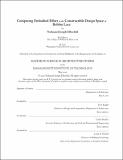Computing embodied effort in the constructible design space of bobbin lace
Author(s)
Elberfeld, Nathaniel Joseph.
Download1196824334-MIT.pdf (12.69Mb)
Other Contributors
Massachusetts Institute of Technology. Department of Architecture.
Advisor
Terry Knight and Caitlin Mueller.
Terms of use
Metadata
Show full item recordAbstract
In recent years, research in design and computation has included processes of making as an expansion of the more established study of shapes with grammar formalism. This interest parallels a rise in craft practices as, perhaps, a counterpoint to the proliferation of digital fabrication in which fidelity to original specifications is considered crucial to the success of a project but whose means and methods are often obfuscated or of secondary importance. Making grammars (Knight and Stiny 2015), by contrast, offer an opportunity to examine one of the most important yet least understood considerations of a design: the effort it takes to physically produce it. This thesis introduces embodied effort as a contribution from human beings or machines that includes the work, steps, routines, applied skill, cognitive processing, or other forms of output that directly contributes to the production of a design. To compute this effort, effort grammars are introduced to expand the formalism of making grammars to include an effort-cost tabulation that corresponds to moments of making. In these grammars, constructability is embedded in a design through an emergent topology in contrast to topologies that emerge through geometric optimization that may solve form or structural considerations but can be highly effortful and costly, or impossible to make. As a case study for computing embodied effort, an effort grammar is developed for a textile production technique called bobbin lacemaking to show how a limited set of making rules can achieve an infinitely variable, complex, and constructible design space. The grammar is used in conjunction with primary sources to identify the physical and cognitive effort required in each step of making bobbin lace and a mathematical model for calculating this embodied effort is introduced. A computer program is written to automate the rules and effort computation on-the-fly and an exploration of the design space is discussed. Effort is situated as critical consideration of contemporary design practice.
Description
Thesis: S.M., Massachusetts Institute of Technology, Department of Architecture, May, 2020 Cataloged from the official PDF of thesis. Includes bibliographical references (pages 115-118).
Date issued
2020Department
Massachusetts Institute of Technology. Department of ArchitecturePublisher
Massachusetts Institute of Technology
Keywords
Architecture.